NIT6042 Thesis 2: IAAS Cloud Scheduling Algorithms Workflow Efficiency
VerifiedAdded on 2023/02/01
|41
|12635
|21
Thesis and Dissertation
AI Summary
This thesis investigates the workflow efficiency of scheduling algorithms and techniques within Infrastructure as a Service (IAAS) in cloud computing. The research aims to determine if these scheduling methods effectively enhance organizational workflows, particularly for both technical and non-technical users. The study employs an inductive research approach, formulating aims and objectives to guide the analysis. An experimental research design is utilized, involving physical experiments to compare existing and current scheduling algorithms. Quantitative research techniques are applied, using statistical tools in MS Excel for data analysis, including descriptive statistics. The results of this research affirm the efficiency of the scheduling techniques or algorithms in IAAS. The results also show that the application software’s is also an efficient technique of cloud computing better than the IAAS. The thesis includes an introduction covering background, aims, objectives, problem statements, motivation, contributions, research topic importance, proposed methodologies, and thesis structure. A literature review examines the concept of IAAS in cloud computing and efficient workflow scheduling. The research methodology details the research problem, approach, design, techniques, data collection, sampling, and ethical considerations. Experiments are designed to compare existing and current techniques, followed by data collection and analysis. The results are presented, discussed, and conclusions drawn, with references and tables/figures to support the findings. The study concludes that the information included in this study will help future scholars in accomplishing their needs in the future period.
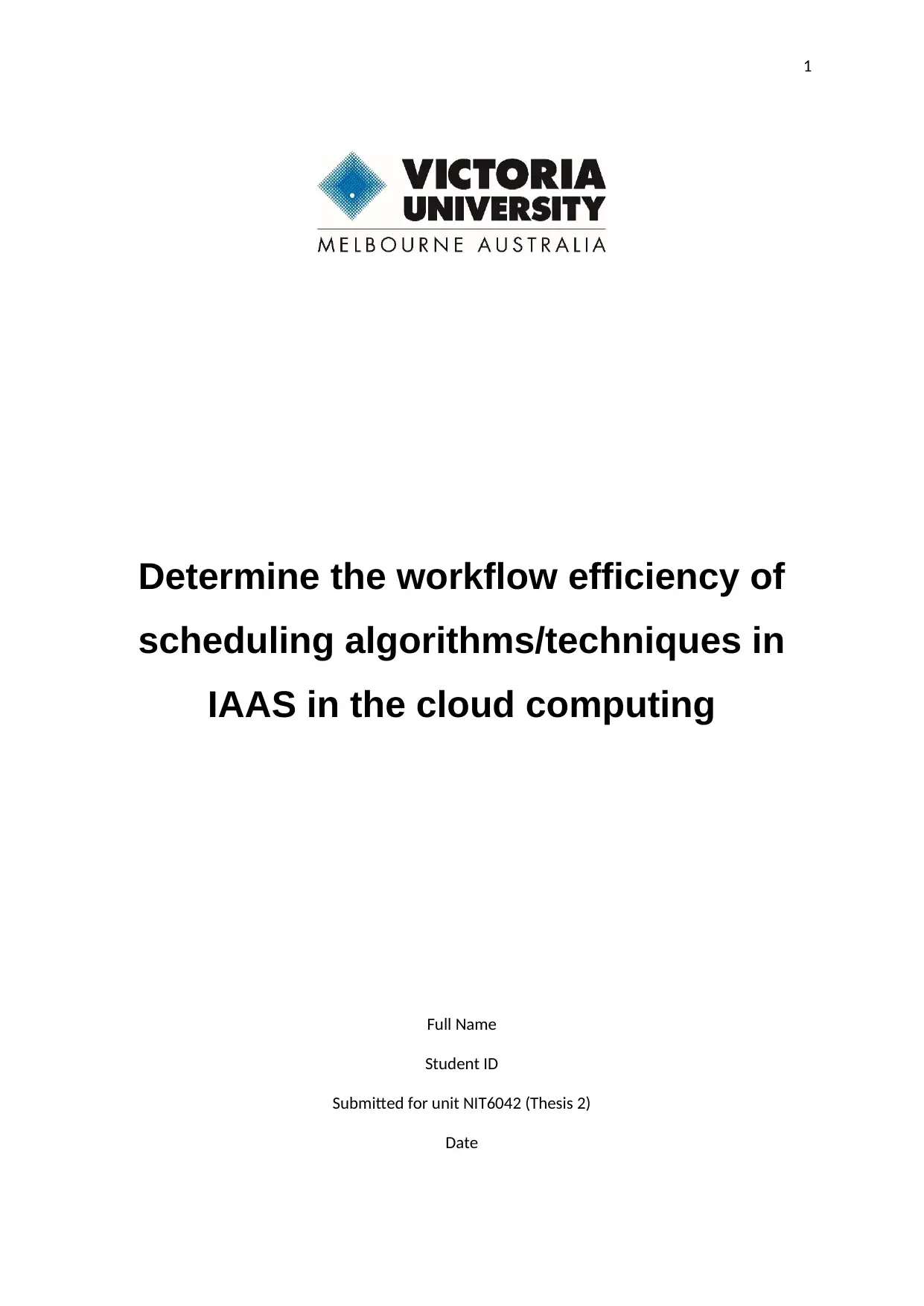
1
Determine the workflow efficiency of
scheduling algorithms/techniques in
IAAS in the cloud computing
Full Name
Student ID
Submitted for unit NIT6042 (Thesis 2)
Date
Determine the workflow efficiency of
scheduling algorithms/techniques in
IAAS in the cloud computing
Full Name
Student ID
Submitted for unit NIT6042 (Thesis 2)
Date
Paraphrase This Document
Need a fresh take? Get an instant paraphrase of this document with our AI Paraphraser
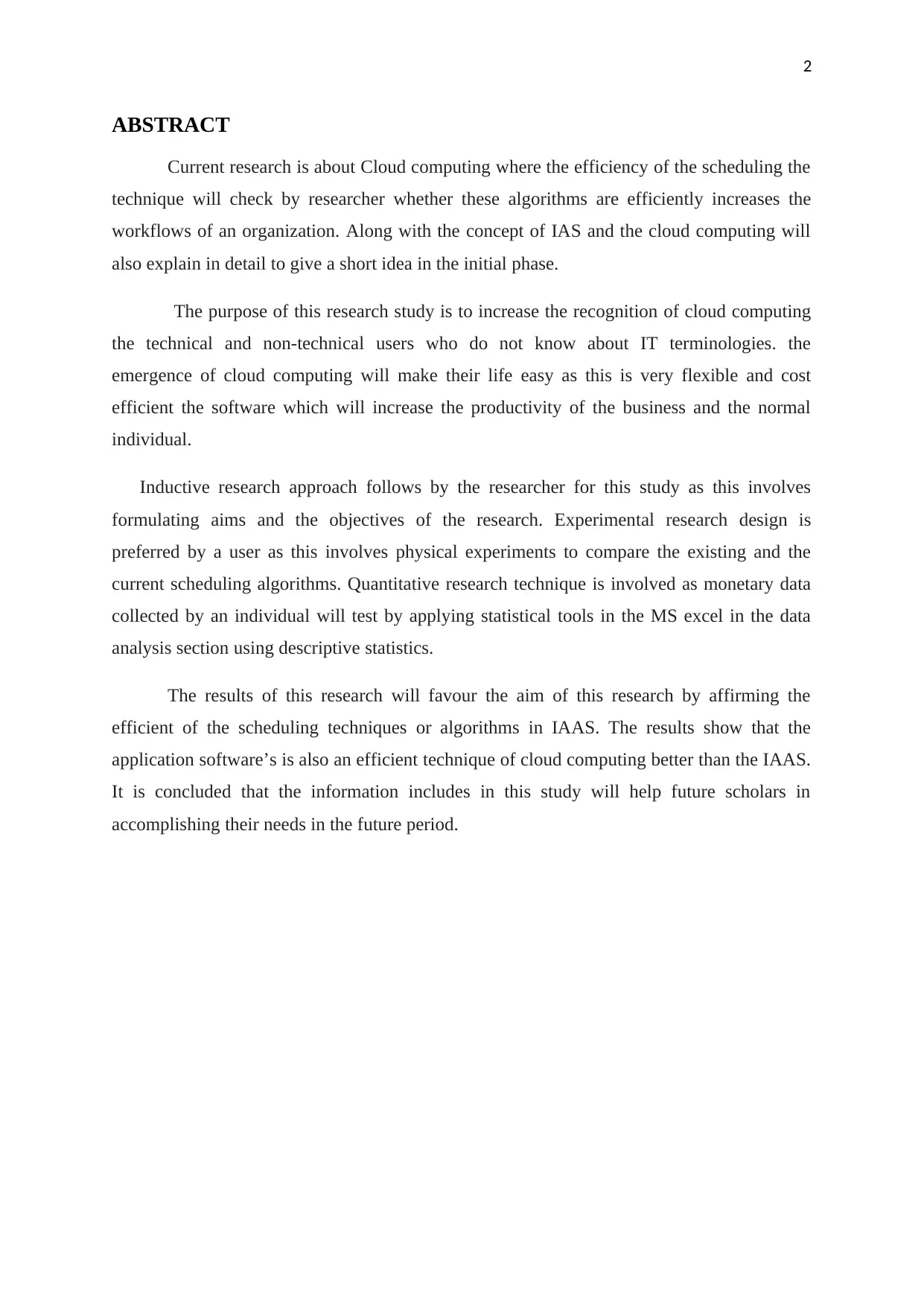
2
ABSTRACT
Current research is about Cloud computing where the efficiency of the scheduling the
technique will check by researcher whether these algorithms are efficiently increases the
workflows of an organization. Along with the concept of IAS and the cloud computing will
also explain in detail to give a short idea in the initial phase.
The purpose of this research study is to increase the recognition of cloud computing
the technical and non-technical users who do not know about IT terminologies. the
emergence of cloud computing will make their life easy as this is very flexible and cost
efficient the software which will increase the productivity of the business and the normal
individual.
Inductive research approach follows by the researcher for this study as this involves
formulating aims and the objectives of the research. Experimental research design is
preferred by a user as this involves physical experiments to compare the existing and the
current scheduling algorithms. Quantitative research technique is involved as monetary data
collected by an individual will test by applying statistical tools in the MS excel in the data
analysis section using descriptive statistics.
The results of this research will favour the aim of this research by affirming the
efficient of the scheduling techniques or algorithms in IAAS. The results show that the
application software’s is also an efficient technique of cloud computing better than the IAAS.
It is concluded that the information includes in this study will help future scholars in
accomplishing their needs in the future period.
ABSTRACT
Current research is about Cloud computing where the efficiency of the scheduling the
technique will check by researcher whether these algorithms are efficiently increases the
workflows of an organization. Along with the concept of IAS and the cloud computing will
also explain in detail to give a short idea in the initial phase.
The purpose of this research study is to increase the recognition of cloud computing
the technical and non-technical users who do not know about IT terminologies. the
emergence of cloud computing will make their life easy as this is very flexible and cost
efficient the software which will increase the productivity of the business and the normal
individual.
Inductive research approach follows by the researcher for this study as this involves
formulating aims and the objectives of the research. Experimental research design is
preferred by a user as this involves physical experiments to compare the existing and the
current scheduling algorithms. Quantitative research technique is involved as monetary data
collected by an individual will test by applying statistical tools in the MS excel in the data
analysis section using descriptive statistics.
The results of this research will favour the aim of this research by affirming the
efficient of the scheduling techniques or algorithms in IAAS. The results show that the
application software’s is also an efficient technique of cloud computing better than the IAAS.
It is concluded that the information includes in this study will help future scholars in
accomplishing their needs in the future period.
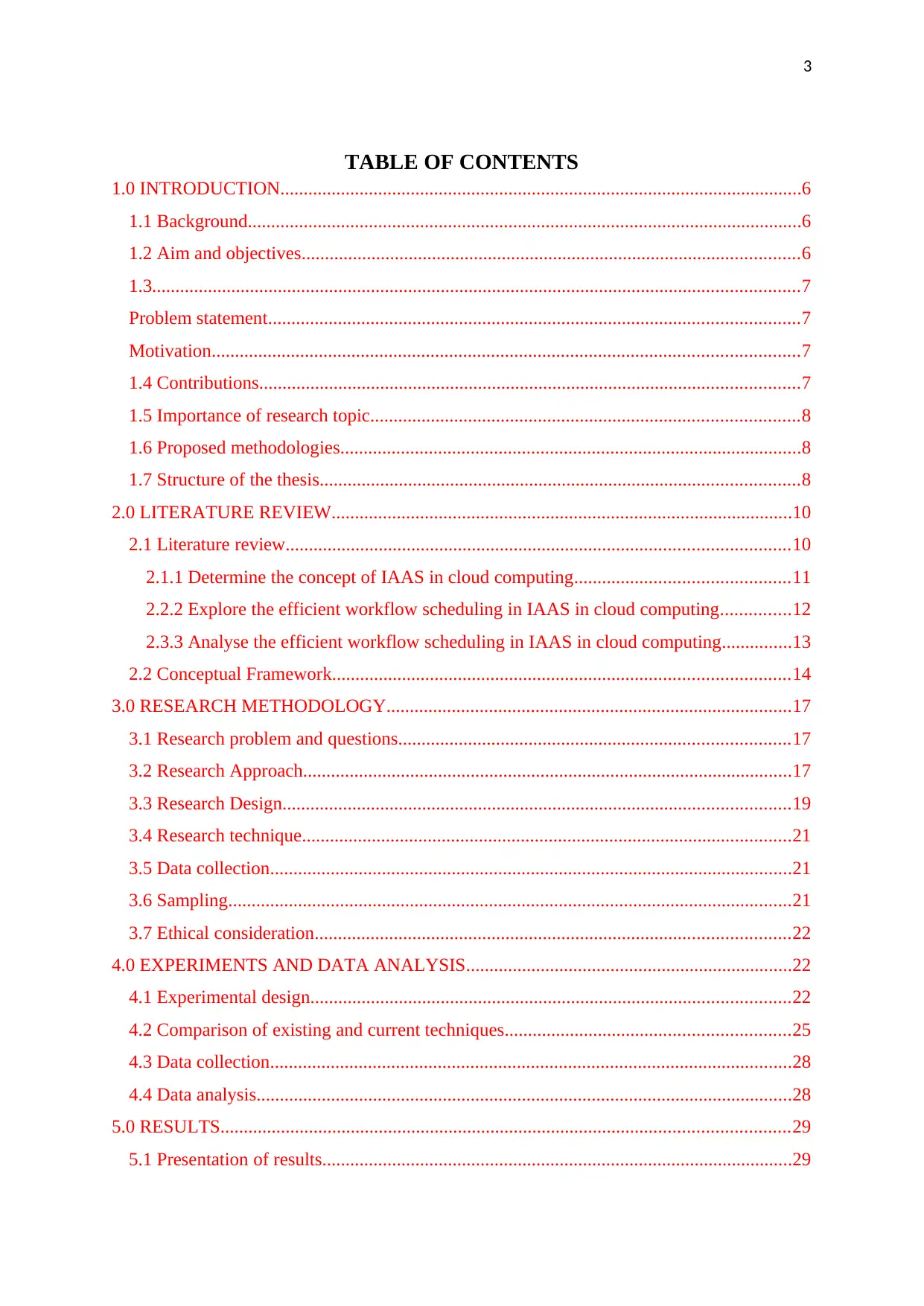
3
TABLE OF CONTENTS
1.0 INTRODUCTION................................................................................................................6
1.1 Background.......................................................................................................................6
1.2 Aim and objectives...........................................................................................................6
1.3...........................................................................................................................................7
Problem statement..................................................................................................................7
Motivation..............................................................................................................................7
1.4 Contributions....................................................................................................................7
1.5 Importance of research topic............................................................................................8
1.6 Proposed methodologies...................................................................................................8
1.7 Structure of the thesis.......................................................................................................8
2.0 LITERATURE REVIEW...................................................................................................10
2.1 Literature review............................................................................................................10
2.1.1 Determine the concept of IAAS in cloud computing..............................................11
2.2.2 Explore the efficient workflow scheduling in IAAS in cloud computing...............12
2.3.3 Analyse the efficient workflow scheduling in IAAS in cloud computing...............13
2.2 Conceptual Framework..................................................................................................14
3.0 RESEARCH METHODOLOGY.......................................................................................17
3.1 Research problem and questions....................................................................................17
3.2 Research Approach.........................................................................................................17
3.3 Research Design.............................................................................................................19
3.4 Research technique.........................................................................................................21
3.5 Data collection................................................................................................................21
3.6 Sampling.........................................................................................................................21
3.7 Ethical consideration......................................................................................................22
4.0 EXPERIMENTS AND DATA ANALYSIS......................................................................22
4.1 Experimental design.......................................................................................................22
4.2 Comparison of existing and current techniques.............................................................25
4.3 Data collection................................................................................................................28
4.4 Data analysis...................................................................................................................28
5.0 RESULTS..........................................................................................................................29
5.1 Presentation of results.....................................................................................................29
TABLE OF CONTENTS
1.0 INTRODUCTION................................................................................................................6
1.1 Background.......................................................................................................................6
1.2 Aim and objectives...........................................................................................................6
1.3...........................................................................................................................................7
Problem statement..................................................................................................................7
Motivation..............................................................................................................................7
1.4 Contributions....................................................................................................................7
1.5 Importance of research topic............................................................................................8
1.6 Proposed methodologies...................................................................................................8
1.7 Structure of the thesis.......................................................................................................8
2.0 LITERATURE REVIEW...................................................................................................10
2.1 Literature review............................................................................................................10
2.1.1 Determine the concept of IAAS in cloud computing..............................................11
2.2.2 Explore the efficient workflow scheduling in IAAS in cloud computing...............12
2.3.3 Analyse the efficient workflow scheduling in IAAS in cloud computing...............13
2.2 Conceptual Framework..................................................................................................14
3.0 RESEARCH METHODOLOGY.......................................................................................17
3.1 Research problem and questions....................................................................................17
3.2 Research Approach.........................................................................................................17
3.3 Research Design.............................................................................................................19
3.4 Research technique.........................................................................................................21
3.5 Data collection................................................................................................................21
3.6 Sampling.........................................................................................................................21
3.7 Ethical consideration......................................................................................................22
4.0 EXPERIMENTS AND DATA ANALYSIS......................................................................22
4.1 Experimental design.......................................................................................................22
4.2 Comparison of existing and current techniques.............................................................25
4.3 Data collection................................................................................................................28
4.4 Data analysis...................................................................................................................28
5.0 RESULTS..........................................................................................................................29
5.1 Presentation of results.....................................................................................................29
⊘ This is a preview!⊘
Do you want full access?
Subscribe today to unlock all pages.

Trusted by 1+ million students worldwide

4
5.2 Discussion.......................................................................................................................34
6.0 CONCLUSION..................................................................................................................35
7.0 REFERENCES...................................................................................................................36
5.2 Discussion.......................................................................................................................34
6.0 CONCLUSION..................................................................................................................35
7.0 REFERENCES...................................................................................................................36
Paraphrase This Document
Need a fresh take? Get an instant paraphrase of this document with our AI Paraphraser
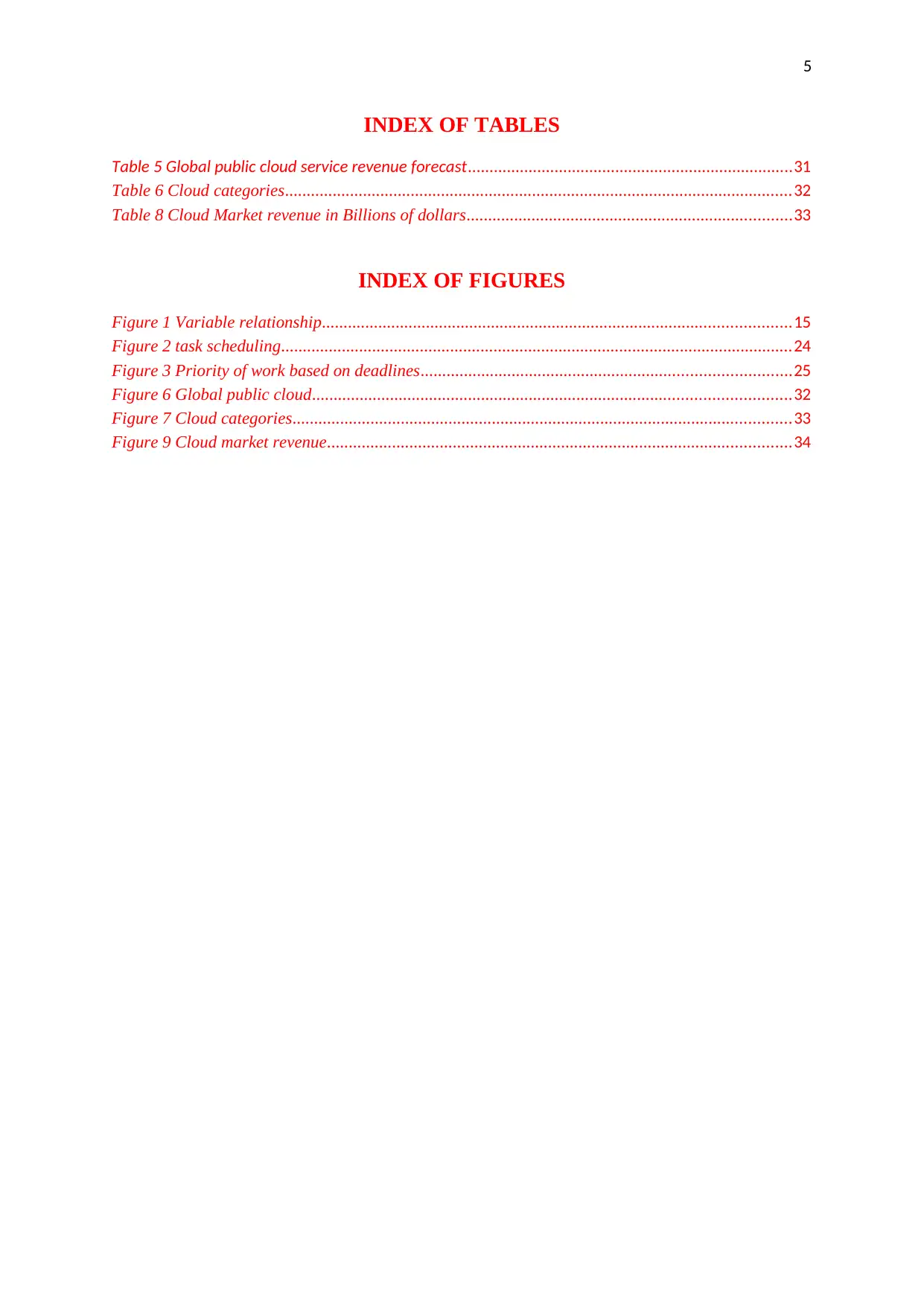
5
INDEX OF TABLES
Table 5 Global public cloud service revenue forecast...........................................................................31
Table 6 Cloud categories.....................................................................................................................32
Table 8 Cloud Market revenue in Billions of dollars...........................................................................33
INDEX OF FIGURES
Figure 1 Variable relationship............................................................................................................15
Figure 2 task scheduling......................................................................................................................24
Figure 3 Priority of work based on deadlines.....................................................................................25
Figure 6 Global public cloud..............................................................................................................32
Figure 7 Cloud categories...................................................................................................................33
Figure 9 Cloud market revenue...........................................................................................................34
INDEX OF TABLES
Table 5 Global public cloud service revenue forecast...........................................................................31
Table 6 Cloud categories.....................................................................................................................32
Table 8 Cloud Market revenue in Billions of dollars...........................................................................33
INDEX OF FIGURES
Figure 1 Variable relationship............................................................................................................15
Figure 2 task scheduling......................................................................................................................24
Figure 3 Priority of work based on deadlines.....................................................................................25
Figure 6 Global public cloud..............................................................................................................32
Figure 7 Cloud categories...................................................................................................................33
Figure 9 Cloud market revenue...........................................................................................................34
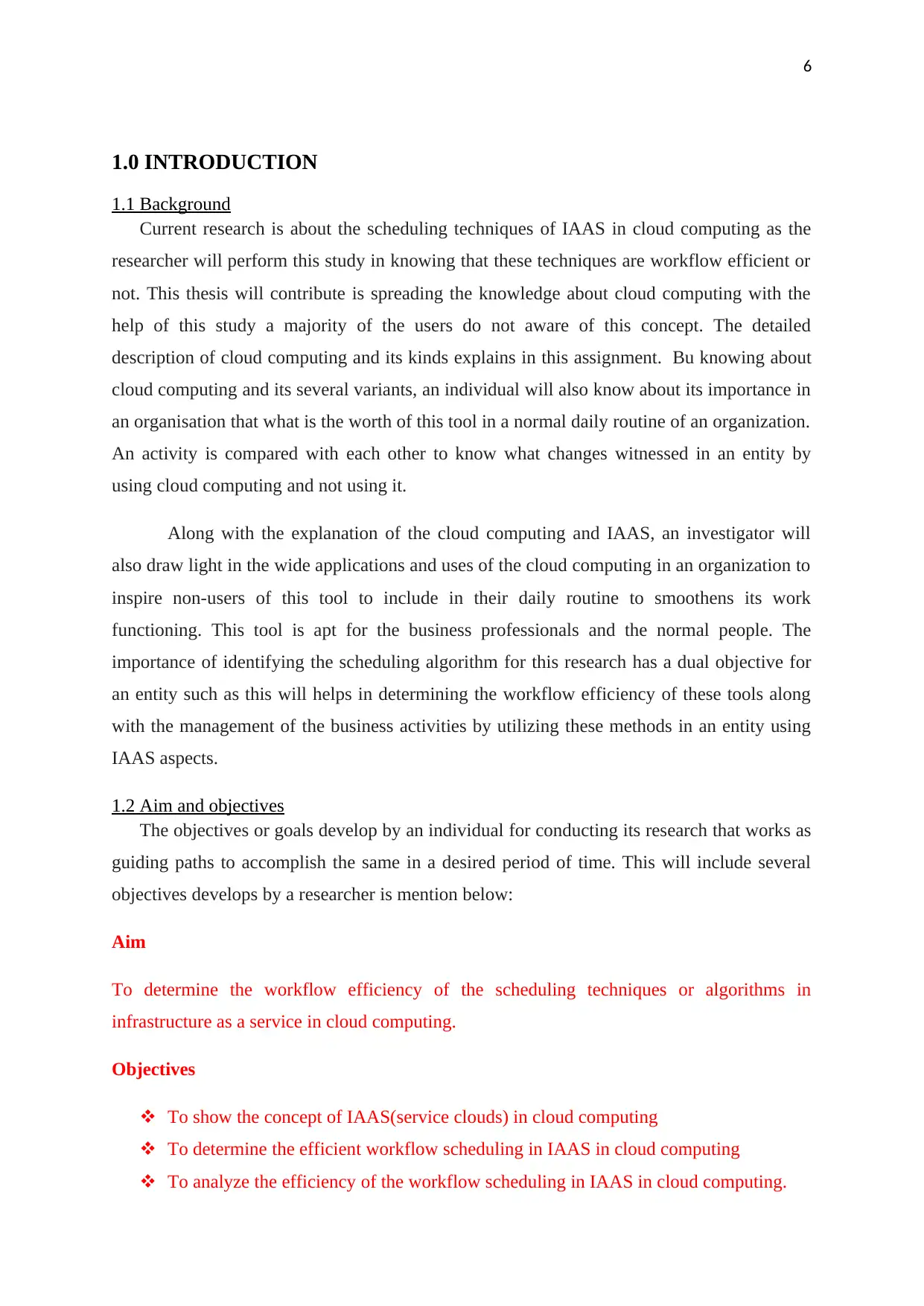
6
1.0 INTRODUCTION
1.1 Background
Current research is about the scheduling techniques of IAAS in cloud computing as the
researcher will perform this study in knowing that these techniques are workflow efficient or
not. This thesis will contribute is spreading the knowledge about cloud computing with the
help of this study a majority of the users do not aware of this concept. The detailed
description of cloud computing and its kinds explains in this assignment. Bu knowing about
cloud computing and its several variants, an individual will also know about its importance in
an organisation that what is the worth of this tool in a normal daily routine of an organization.
An activity is compared with each other to know what changes witnessed in an entity by
using cloud computing and not using it.
Along with the explanation of the cloud computing and IAAS, an investigator will
also draw light in the wide applications and uses of the cloud computing in an organization to
inspire non-users of this tool to include in their daily routine to smoothens its work
functioning. This tool is apt for the business professionals and the normal people. The
importance of identifying the scheduling algorithm for this research has a dual objective for
an entity such as this will helps in determining the workflow efficiency of these tools along
with the management of the business activities by utilizing these methods in an entity using
IAAS aspects.
1.2 Aim and objectives
The objectives or goals develop by an individual for conducting its research that works as
guiding paths to accomplish the same in a desired period of time. This will include several
objectives develops by a researcher is mention below:
Aim
To determine the workflow efficiency of the scheduling techniques or algorithms in
infrastructure as a service in cloud computing.
Objectives
To show the concept of IAAS(service clouds) in cloud computing
To determine the efficient workflow scheduling in IAAS in cloud computing
To analyze the efficiency of the workflow scheduling in IAAS in cloud computing.
1.0 INTRODUCTION
1.1 Background
Current research is about the scheduling techniques of IAAS in cloud computing as the
researcher will perform this study in knowing that these techniques are workflow efficient or
not. This thesis will contribute is spreading the knowledge about cloud computing with the
help of this study a majority of the users do not aware of this concept. The detailed
description of cloud computing and its kinds explains in this assignment. Bu knowing about
cloud computing and its several variants, an individual will also know about its importance in
an organisation that what is the worth of this tool in a normal daily routine of an organization.
An activity is compared with each other to know what changes witnessed in an entity by
using cloud computing and not using it.
Along with the explanation of the cloud computing and IAAS, an investigator will
also draw light in the wide applications and uses of the cloud computing in an organization to
inspire non-users of this tool to include in their daily routine to smoothens its work
functioning. This tool is apt for the business professionals and the normal people. The
importance of identifying the scheduling algorithm for this research has a dual objective for
an entity such as this will helps in determining the workflow efficiency of these tools along
with the management of the business activities by utilizing these methods in an entity using
IAAS aspects.
1.2 Aim and objectives
The objectives or goals develop by an individual for conducting its research that works as
guiding paths to accomplish the same in a desired period of time. This will include several
objectives develops by a researcher is mention below:
Aim
To determine the workflow efficiency of the scheduling techniques or algorithms in
infrastructure as a service in cloud computing.
Objectives
To show the concept of IAAS(service clouds) in cloud computing
To determine the efficient workflow scheduling in IAAS in cloud computing
To analyze the efficiency of the workflow scheduling in IAAS in cloud computing.
⊘ This is a preview!⊘
Do you want full access?
Subscribe today to unlock all pages.

Trusted by 1+ million students worldwide
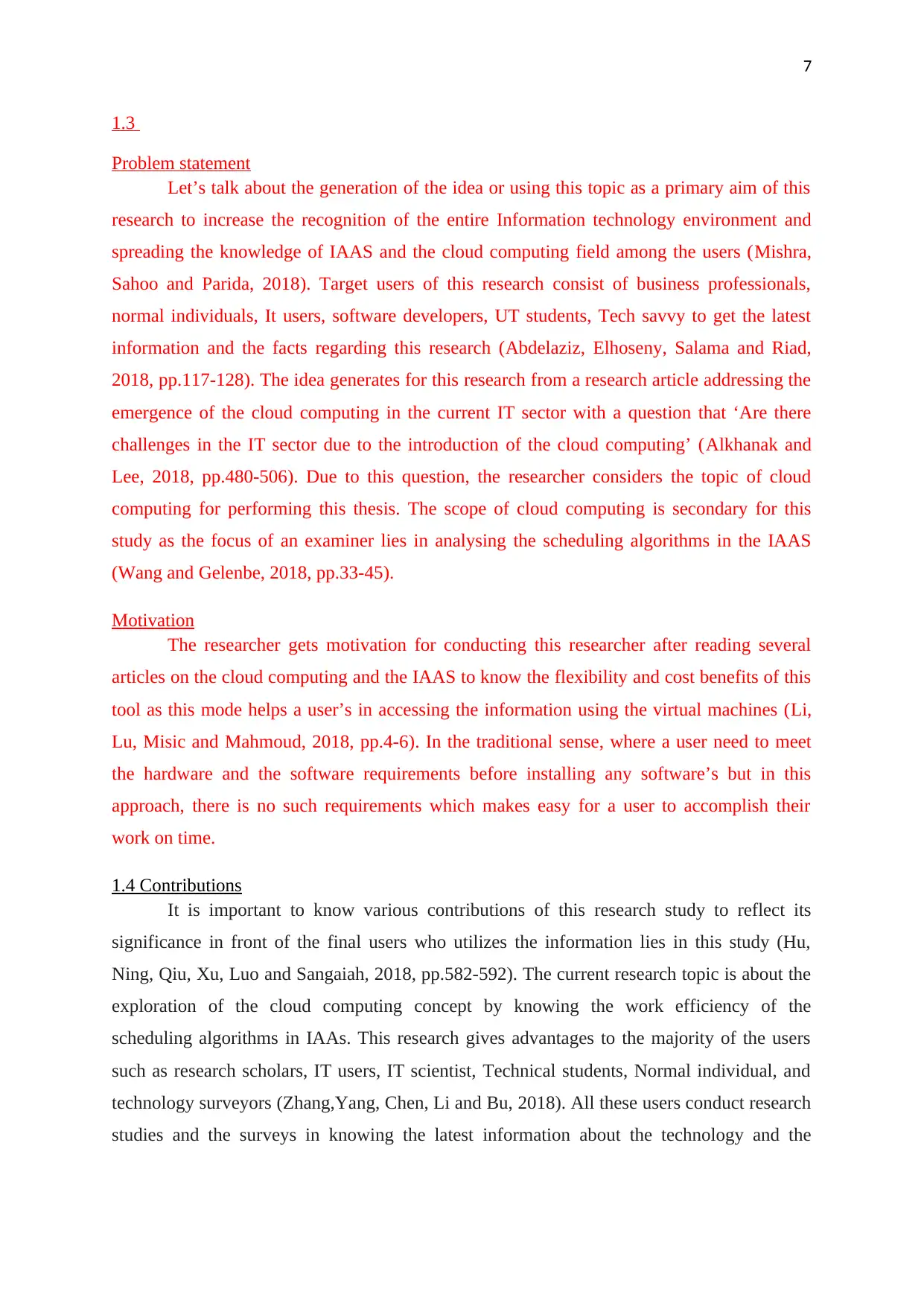
7
1.3
Problem statement
Let’s talk about the generation of the idea or using this topic as a primary aim of this
research to increase the recognition of the entire Information technology environment and
spreading the knowledge of IAAS and the cloud computing field among the users (Mishra,
Sahoo and Parida, 2018). Target users of this research consist of business professionals,
normal individuals, It users, software developers, UT students, Tech savvy to get the latest
information and the facts regarding this research (Abdelaziz, Elhoseny, Salama and Riad,
2018, pp.117-128). The idea generates for this research from a research article addressing the
emergence of the cloud computing in the current IT sector with a question that ‘Are there
challenges in the IT sector due to the introduction of the cloud computing’ (Alkhanak and
Lee, 2018, pp.480-506). Due to this question, the researcher considers the topic of cloud
computing for performing this thesis. The scope of cloud computing is secondary for this
study as the focus of an examiner lies in analysing the scheduling algorithms in the IAAS
(Wang and Gelenbe, 2018, pp.33-45).
Motivation
The researcher gets motivation for conducting this researcher after reading several
articles on the cloud computing and the IAAS to know the flexibility and cost benefits of this
tool as this mode helps a user’s in accessing the information using the virtual machines (Li,
Lu, Misic and Mahmoud, 2018, pp.4-6). In the traditional sense, where a user need to meet
the hardware and the software requirements before installing any software’s but in this
approach, there is no such requirements which makes easy for a user to accomplish their
work on time.
1.4 Contributions
It is important to know various contributions of this research study to reflect its
significance in front of the final users who utilizes the information lies in this study (Hu,
Ning, Qiu, Xu, Luo and Sangaiah, 2018, pp.582-592). The current research topic is about the
exploration of the cloud computing concept by knowing the work efficiency of the
scheduling algorithms in IAAs. This research gives advantages to the majority of the users
such as research scholars, IT users, IT scientist, Technical students, Normal individual, and
technology surveyors (Zhang,Yang, Chen, Li and Bu, 2018). All these users conduct research
studies and the surveys in knowing the latest information about the technology and the
1.3
Problem statement
Let’s talk about the generation of the idea or using this topic as a primary aim of this
research to increase the recognition of the entire Information technology environment and
spreading the knowledge of IAAS and the cloud computing field among the users (Mishra,
Sahoo and Parida, 2018). Target users of this research consist of business professionals,
normal individuals, It users, software developers, UT students, Tech savvy to get the latest
information and the facts regarding this research (Abdelaziz, Elhoseny, Salama and Riad,
2018, pp.117-128). The idea generates for this research from a research article addressing the
emergence of the cloud computing in the current IT sector with a question that ‘Are there
challenges in the IT sector due to the introduction of the cloud computing’ (Alkhanak and
Lee, 2018, pp.480-506). Due to this question, the researcher considers the topic of cloud
computing for performing this thesis. The scope of cloud computing is secondary for this
study as the focus of an examiner lies in analysing the scheduling algorithms in the IAAS
(Wang and Gelenbe, 2018, pp.33-45).
Motivation
The researcher gets motivation for conducting this researcher after reading several
articles on the cloud computing and the IAAS to know the flexibility and cost benefits of this
tool as this mode helps a user’s in accessing the information using the virtual machines (Li,
Lu, Misic and Mahmoud, 2018, pp.4-6). In the traditional sense, where a user need to meet
the hardware and the software requirements before installing any software’s but in this
approach, there is no such requirements which makes easy for a user to accomplish their
work on time.
1.4 Contributions
It is important to know various contributions of this research study to reflect its
significance in front of the final users who utilizes the information lies in this study (Hu,
Ning, Qiu, Xu, Luo and Sangaiah, 2018, pp.582-592). The current research topic is about the
exploration of the cloud computing concept by knowing the work efficiency of the
scheduling algorithms in IAAs. This research gives advantages to the majority of the users
such as research scholars, IT users, IT scientist, Technical students, Normal individual, and
technology surveyors (Zhang,Yang, Chen, Li and Bu, 2018). All these users conduct research
studies and the surveys in knowing the latest information about the technology and the
Paraphrase This Document
Need a fresh take? Get an instant paraphrase of this document with our AI Paraphraser
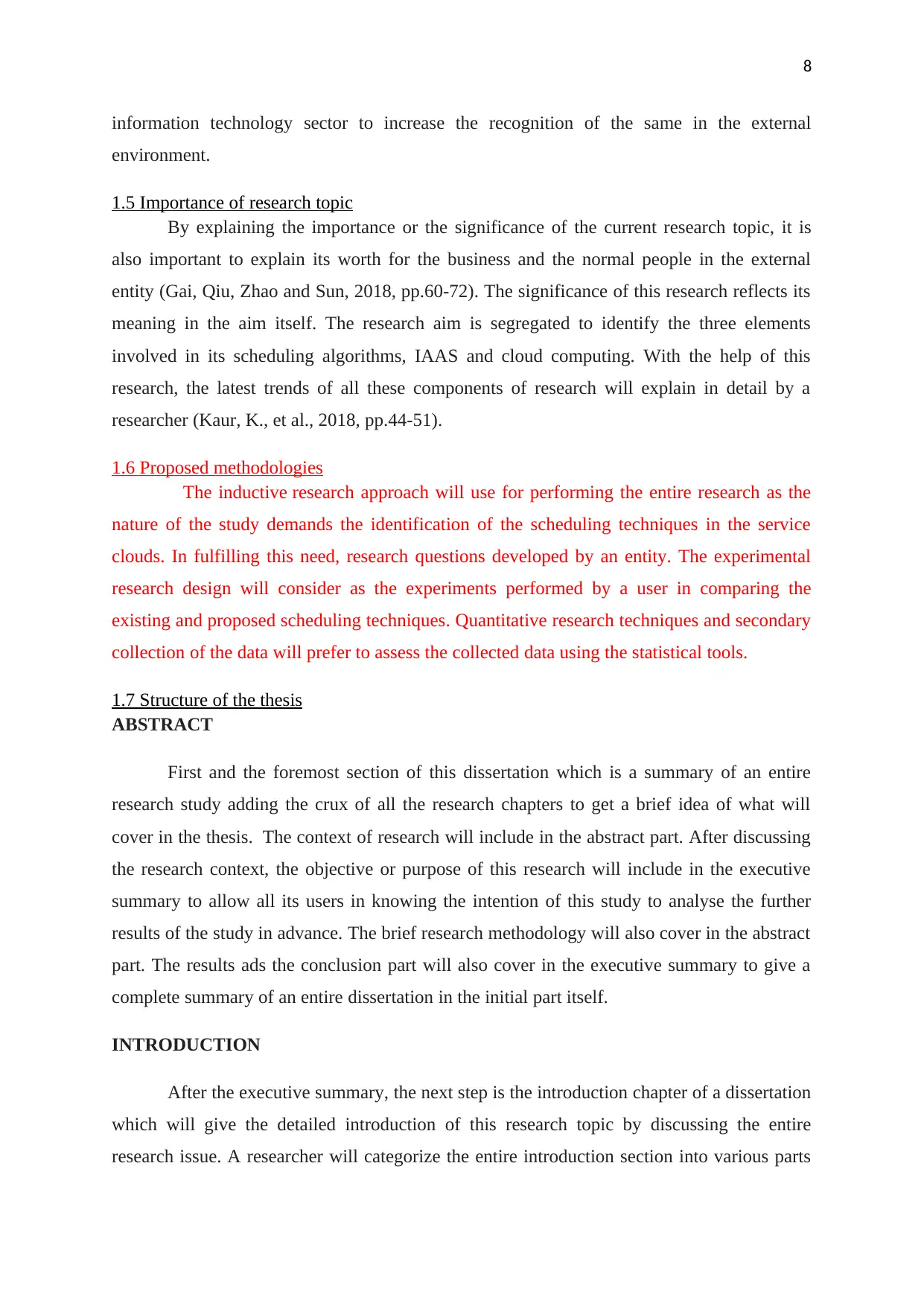
8
information technology sector to increase the recognition of the same in the external
environment.
1.5 Importance of research topic
By explaining the importance or the significance of the current research topic, it is
also important to explain its worth for the business and the normal people in the external
entity (Gai, Qiu, Zhao and Sun, 2018, pp.60-72). The significance of this research reflects its
meaning in the aim itself. The research aim is segregated to identify the three elements
involved in its scheduling algorithms, IAAS and cloud computing. With the help of this
research, the latest trends of all these components of research will explain in detail by a
researcher (Kaur, K., et al., 2018, pp.44-51).
1.6 Proposed methodologies
The inductive research approach will use for performing the entire research as the
nature of the study demands the identification of the scheduling techniques in the service
clouds. In fulfilling this need, research questions developed by an entity. The experimental
research design will consider as the experiments performed by a user in comparing the
existing and proposed scheduling techniques. Quantitative research techniques and secondary
collection of the data will prefer to assess the collected data using the statistical tools.
1.7 Structure of the thesis
ABSTRACT
First and the foremost section of this dissertation which is a summary of an entire
research study adding the crux of all the research chapters to get a brief idea of what will
cover in the thesis. The context of research will include in the abstract part. After discussing
the research context, the objective or purpose of this research will include in the executive
summary to allow all its users in knowing the intention of this study to analyse the further
results of the study in advance. The brief research methodology will also cover in the abstract
part. The results ads the conclusion part will also cover in the executive summary to give a
complete summary of an entire dissertation in the initial part itself.
INTRODUCTION
After the executive summary, the next step is the introduction chapter of a dissertation
which will give the detailed introduction of this research topic by discussing the entire
research issue. A researcher will categorize the entire introduction section into various parts
information technology sector to increase the recognition of the same in the external
environment.
1.5 Importance of research topic
By explaining the importance or the significance of the current research topic, it is
also important to explain its worth for the business and the normal people in the external
entity (Gai, Qiu, Zhao and Sun, 2018, pp.60-72). The significance of this research reflects its
meaning in the aim itself. The research aim is segregated to identify the three elements
involved in its scheduling algorithms, IAAS and cloud computing. With the help of this
research, the latest trends of all these components of research will explain in detail by a
researcher (Kaur, K., et al., 2018, pp.44-51).
1.6 Proposed methodologies
The inductive research approach will use for performing the entire research as the
nature of the study demands the identification of the scheduling techniques in the service
clouds. In fulfilling this need, research questions developed by an entity. The experimental
research design will consider as the experiments performed by a user in comparing the
existing and proposed scheduling techniques. Quantitative research techniques and secondary
collection of the data will prefer to assess the collected data using the statistical tools.
1.7 Structure of the thesis
ABSTRACT
First and the foremost section of this dissertation which is a summary of an entire
research study adding the crux of all the research chapters to get a brief idea of what will
cover in the thesis. The context of research will include in the abstract part. After discussing
the research context, the objective or purpose of this research will include in the executive
summary to allow all its users in knowing the intention of this study to analyse the further
results of the study in advance. The brief research methodology will also cover in the abstract
part. The results ads the conclusion part will also cover in the executive summary to give a
complete summary of an entire dissertation in the initial part itself.
INTRODUCTION
After the executive summary, the next step is the introduction chapter of a dissertation
which will give the detailed introduction of this research topic by discussing the entire
research issue. A researcher will categorize the entire introduction section into various parts
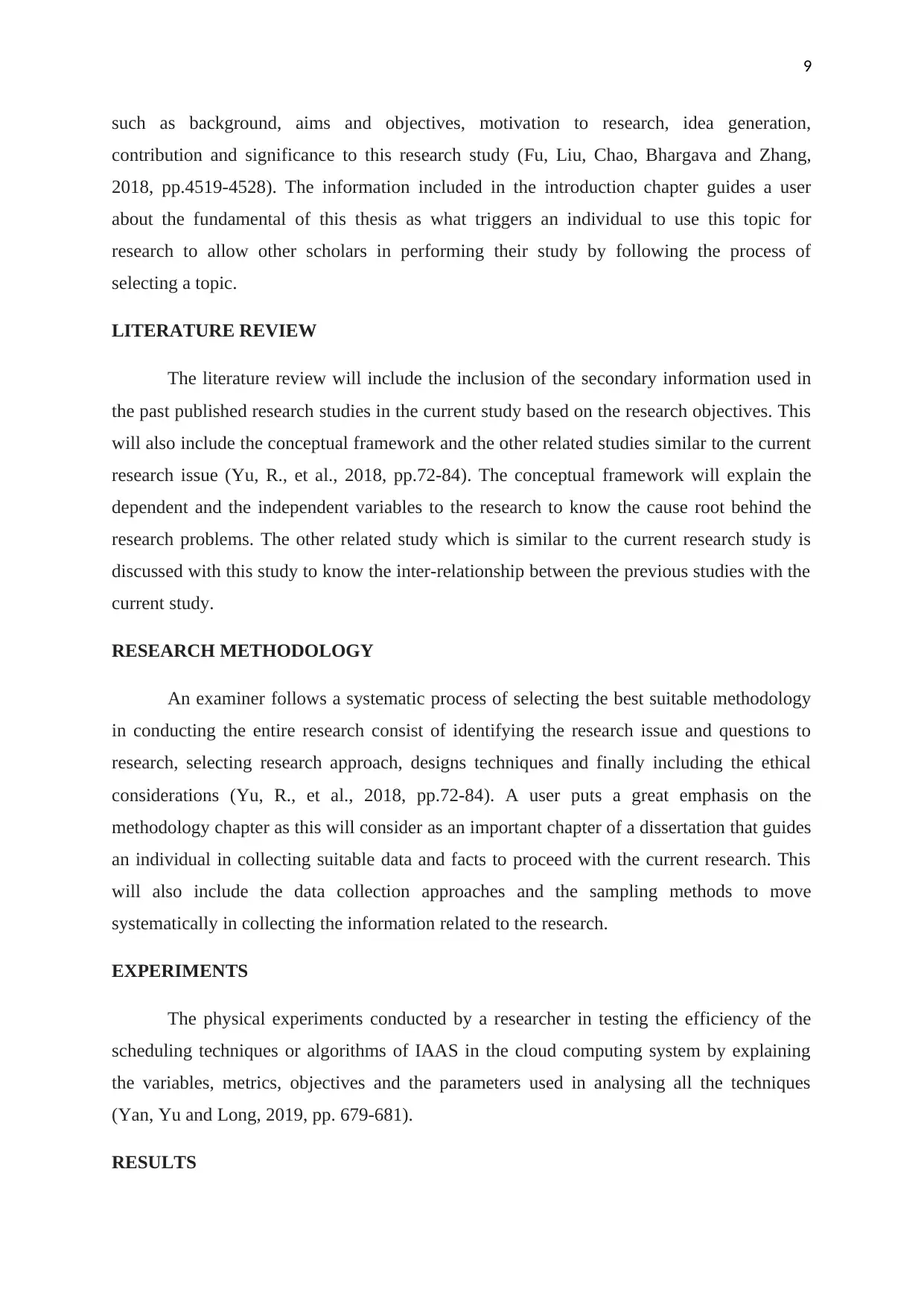
9
such as background, aims and objectives, motivation to research, idea generation,
contribution and significance to this research study (Fu, Liu, Chao, Bhargava and Zhang,
2018, pp.4519-4528). The information included in the introduction chapter guides a user
about the fundamental of this thesis as what triggers an individual to use this topic for
research to allow other scholars in performing their study by following the process of
selecting a topic.
LITERATURE REVIEW
The literature review will include the inclusion of the secondary information used in
the past published research studies in the current study based on the research objectives. This
will also include the conceptual framework and the other related studies similar to the current
research issue (Yu, R., et al., 2018, pp.72-84). The conceptual framework will explain the
dependent and the independent variables to the research to know the cause root behind the
research problems. The other related study which is similar to the current research study is
discussed with this study to know the inter-relationship between the previous studies with the
current study.
RESEARCH METHODOLOGY
An examiner follows a systematic process of selecting the best suitable methodology
in conducting the entire research consist of identifying the research issue and questions to
research, selecting research approach, designs techniques and finally including the ethical
considerations (Yu, R., et al., 2018, pp.72-84). A user puts a great emphasis on the
methodology chapter as this will consider as an important chapter of a dissertation that guides
an individual in collecting suitable data and facts to proceed with the current research. This
will also include the data collection approaches and the sampling methods to move
systematically in collecting the information related to the research.
EXPERIMENTS
The physical experiments conducted by a researcher in testing the efficiency of the
scheduling techniques or algorithms of IAAS in the cloud computing system by explaining
the variables, metrics, objectives and the parameters used in analysing all the techniques
(Yan, Yu and Long, 2019, pp. 679-681).
RESULTS
such as background, aims and objectives, motivation to research, idea generation,
contribution and significance to this research study (Fu, Liu, Chao, Bhargava and Zhang,
2018, pp.4519-4528). The information included in the introduction chapter guides a user
about the fundamental of this thesis as what triggers an individual to use this topic for
research to allow other scholars in performing their study by following the process of
selecting a topic.
LITERATURE REVIEW
The literature review will include the inclusion of the secondary information used in
the past published research studies in the current study based on the research objectives. This
will also include the conceptual framework and the other related studies similar to the current
research issue (Yu, R., et al., 2018, pp.72-84). The conceptual framework will explain the
dependent and the independent variables to the research to know the cause root behind the
research problems. The other related study which is similar to the current research study is
discussed with this study to know the inter-relationship between the previous studies with the
current study.
RESEARCH METHODOLOGY
An examiner follows a systematic process of selecting the best suitable methodology
in conducting the entire research consist of identifying the research issue and questions to
research, selecting research approach, designs techniques and finally including the ethical
considerations (Yu, R., et al., 2018, pp.72-84). A user puts a great emphasis on the
methodology chapter as this will consider as an important chapter of a dissertation that guides
an individual in collecting suitable data and facts to proceed with the current research. This
will also include the data collection approaches and the sampling methods to move
systematically in collecting the information related to the research.
EXPERIMENTS
The physical experiments conducted by a researcher in testing the efficiency of the
scheduling techniques or algorithms of IAAS in the cloud computing system by explaining
the variables, metrics, objectives and the parameters used in analysing all the techniques
(Yan, Yu and Long, 2019, pp. 679-681).
RESULTS
⊘ This is a preview!⊘
Do you want full access?
Subscribe today to unlock all pages.

Trusted by 1+ million students worldwide
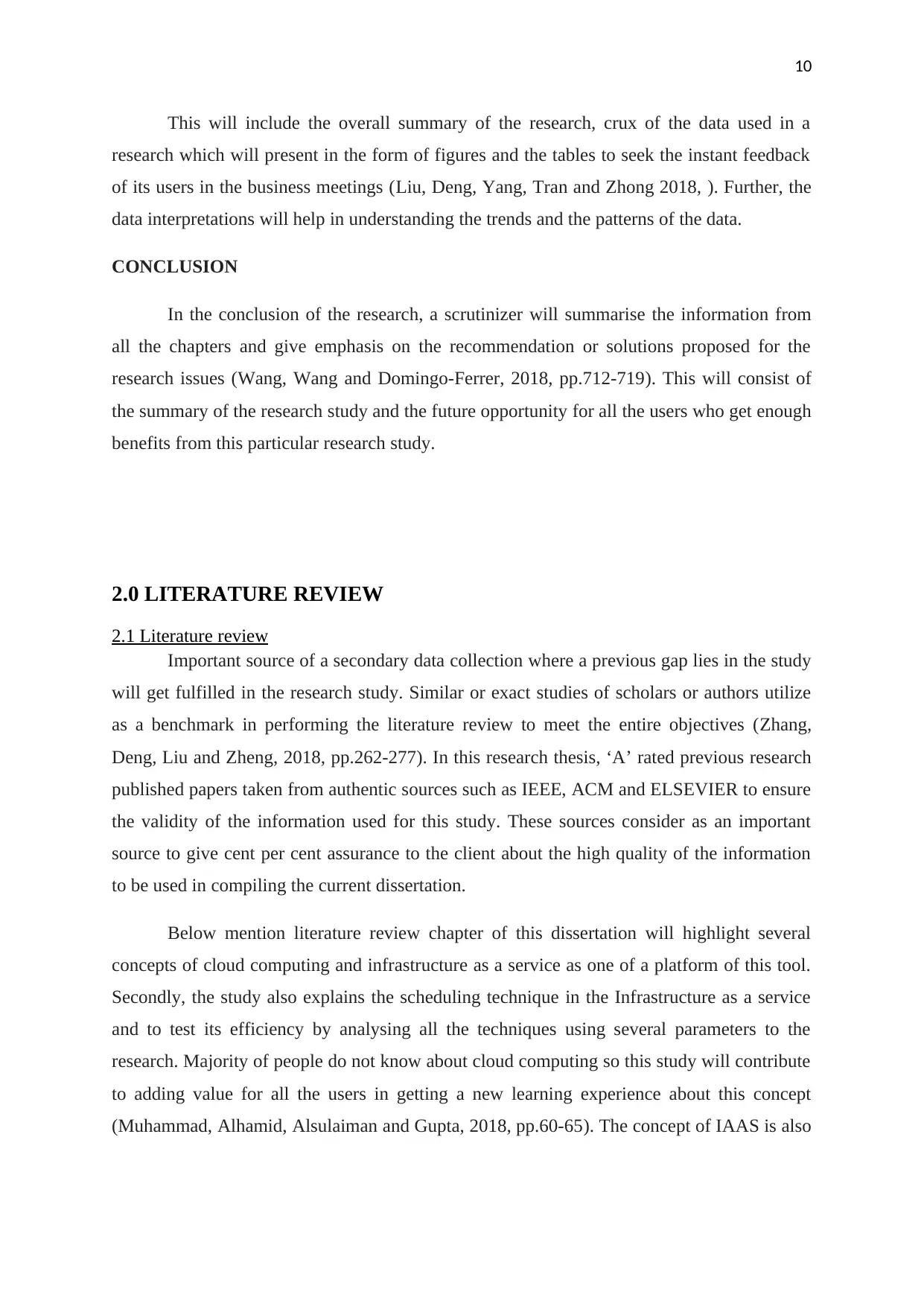
10
This will include the overall summary of the research, crux of the data used in a
research which will present in the form of figures and the tables to seek the instant feedback
of its users in the business meetings (Liu, Deng, Yang, Tran and Zhong 2018, ). Further, the
data interpretations will help in understanding the trends and the patterns of the data.
CONCLUSION
In the conclusion of the research, a scrutinizer will summarise the information from
all the chapters and give emphasis on the recommendation or solutions proposed for the
research issues (Wang, Wang and Domingo-Ferrer, 2018, pp.712-719). This will consist of
the summary of the research study and the future opportunity for all the users who get enough
benefits from this particular research study.
2.0 LITERATURE REVIEW
2.1 Literature review
Important source of a secondary data collection where a previous gap lies in the study
will get fulfilled in the research study. Similar or exact studies of scholars or authors utilize
as a benchmark in performing the literature review to meet the entire objectives (Zhang,
Deng, Liu and Zheng, 2018, pp.262-277). In this research thesis, ‘A’ rated previous research
published papers taken from authentic sources such as IEEE, ACM and ELSEVIER to ensure
the validity of the information used for this study. These sources consider as an important
source to give cent per cent assurance to the client about the high quality of the information
to be used in compiling the current dissertation.
Below mention literature review chapter of this dissertation will highlight several
concepts of cloud computing and infrastructure as a service as one of a platform of this tool.
Secondly, the study also explains the scheduling technique in the Infrastructure as a service
and to test its efficiency by analysing all the techniques using several parameters to the
research. Majority of people do not know about cloud computing so this study will contribute
to adding value for all the users in getting a new learning experience about this concept
(Muhammad, Alhamid, Alsulaiman and Gupta, 2018, pp.60-65). The concept of IAAS is also
This will include the overall summary of the research, crux of the data used in a
research which will present in the form of figures and the tables to seek the instant feedback
of its users in the business meetings (Liu, Deng, Yang, Tran and Zhong 2018, ). Further, the
data interpretations will help in understanding the trends and the patterns of the data.
CONCLUSION
In the conclusion of the research, a scrutinizer will summarise the information from
all the chapters and give emphasis on the recommendation or solutions proposed for the
research issues (Wang, Wang and Domingo-Ferrer, 2018, pp.712-719). This will consist of
the summary of the research study and the future opportunity for all the users who get enough
benefits from this particular research study.
2.0 LITERATURE REVIEW
2.1 Literature review
Important source of a secondary data collection where a previous gap lies in the study
will get fulfilled in the research study. Similar or exact studies of scholars or authors utilize
as a benchmark in performing the literature review to meet the entire objectives (Zhang,
Deng, Liu and Zheng, 2018, pp.262-277). In this research thesis, ‘A’ rated previous research
published papers taken from authentic sources such as IEEE, ACM and ELSEVIER to ensure
the validity of the information used for this study. These sources consider as an important
source to give cent per cent assurance to the client about the high quality of the information
to be used in compiling the current dissertation.
Below mention literature review chapter of this dissertation will highlight several
concepts of cloud computing and infrastructure as a service as one of a platform of this tool.
Secondly, the study also explains the scheduling technique in the Infrastructure as a service
and to test its efficiency by analysing all the techniques using several parameters to the
research. Majority of people do not know about cloud computing so this study will contribute
to adding value for all the users in getting a new learning experience about this concept
(Muhammad, Alhamid, Alsulaiman and Gupta, 2018, pp.60-65). The concept of IAAS is also
Paraphrase This Document
Need a fresh take? Get an instant paraphrase of this document with our AI Paraphraser
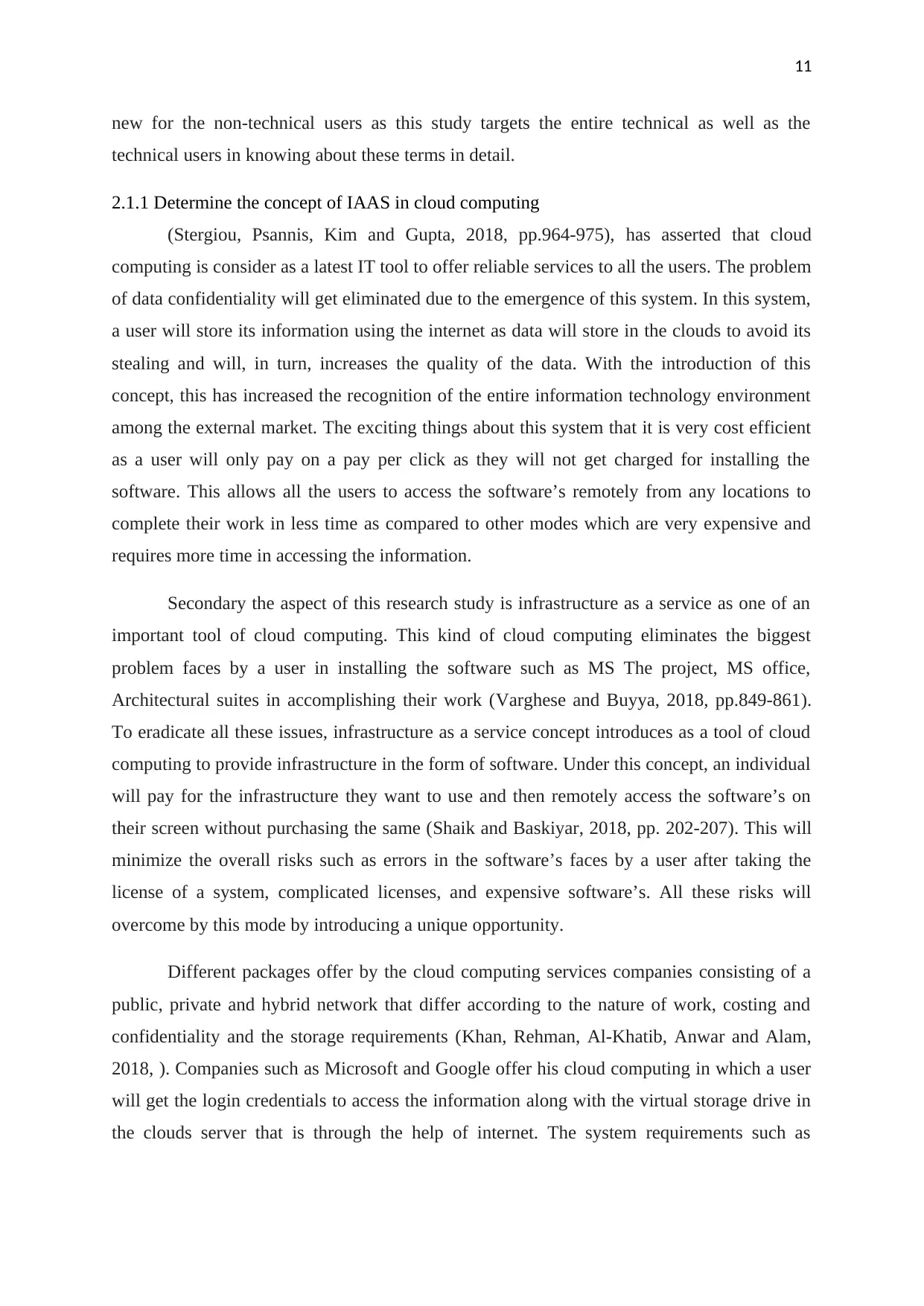
11
new for the non-technical users as this study targets the entire technical as well as the
technical users in knowing about these terms in detail.
2.1.1 Determine the concept of IAAS in cloud computing
(Stergiou, Psannis, Kim and Gupta, 2018, pp.964-975), has asserted that cloud
computing is consider as a latest IT tool to offer reliable services to all the users. The problem
of data confidentiality will get eliminated due to the emergence of this system. In this system,
a user will store its information using the internet as data will store in the clouds to avoid its
stealing and will, in turn, increases the quality of the data. With the introduction of this
concept, this has increased the recognition of the entire information technology environment
among the external market. The exciting things about this system that it is very cost efficient
as a user will only pay on a pay per click as they will not get charged for installing the
software. This allows all the users to access the software’s remotely from any locations to
complete their work in less time as compared to other modes which are very expensive and
requires more time in accessing the information.
Secondary the aspect of this research study is infrastructure as a service as one of an
important tool of cloud computing. This kind of cloud computing eliminates the biggest
problem faces by a user in installing the software such as MS The project, MS office,
Architectural suites in accomplishing their work (Varghese and Buyya, 2018, pp.849-861).
To eradicate all these issues, infrastructure as a service concept introduces as a tool of cloud
computing to provide infrastructure in the form of software. Under this concept, an individual
will pay for the infrastructure they want to use and then remotely access the software’s on
their screen without purchasing the same (Shaik and Baskiyar, 2018, pp. 202-207). This will
minimize the overall risks such as errors in the software’s faces by a user after taking the
license of a system, complicated licenses, and expensive software’s. All these risks will
overcome by this mode by introducing a unique opportunity.
Different packages offer by the cloud computing services companies consisting of a
public, private and hybrid network that differ according to the nature of work, costing and
confidentiality and the storage requirements (Khan, Rehman, Al-Khatib, Anwar and Alam,
2018, ). Companies such as Microsoft and Google offer his cloud computing in which a user
will get the login credentials to access the information along with the virtual storage drive in
the clouds server that is through the help of internet. The system requirements such as
new for the non-technical users as this study targets the entire technical as well as the
technical users in knowing about these terms in detail.
2.1.1 Determine the concept of IAAS in cloud computing
(Stergiou, Psannis, Kim and Gupta, 2018, pp.964-975), has asserted that cloud
computing is consider as a latest IT tool to offer reliable services to all the users. The problem
of data confidentiality will get eliminated due to the emergence of this system. In this system,
a user will store its information using the internet as data will store in the clouds to avoid its
stealing and will, in turn, increases the quality of the data. With the introduction of this
concept, this has increased the recognition of the entire information technology environment
among the external market. The exciting things about this system that it is very cost efficient
as a user will only pay on a pay per click as they will not get charged for installing the
software. This allows all the users to access the software’s remotely from any locations to
complete their work in less time as compared to other modes which are very expensive and
requires more time in accessing the information.
Secondary the aspect of this research study is infrastructure as a service as one of an
important tool of cloud computing. This kind of cloud computing eliminates the biggest
problem faces by a user in installing the software such as MS The project, MS office,
Architectural suites in accomplishing their work (Varghese and Buyya, 2018, pp.849-861).
To eradicate all these issues, infrastructure as a service concept introduces as a tool of cloud
computing to provide infrastructure in the form of software. Under this concept, an individual
will pay for the infrastructure they want to use and then remotely access the software’s on
their screen without purchasing the same (Shaik and Baskiyar, 2018, pp. 202-207). This will
minimize the overall risks such as errors in the software’s faces by a user after taking the
license of a system, complicated licenses, and expensive software’s. All these risks will
overcome by this mode by introducing a unique opportunity.
Different packages offer by the cloud computing services companies consisting of a
public, private and hybrid network that differ according to the nature of work, costing and
confidentiality and the storage requirements (Khan, Rehman, Al-Khatib, Anwar and Alam,
2018, ). Companies such as Microsoft and Google offer his cloud computing in which a user
will get the login credentials to access the information along with the virtual storage drive in
the clouds server that is through the help of internet. The system requirements such as
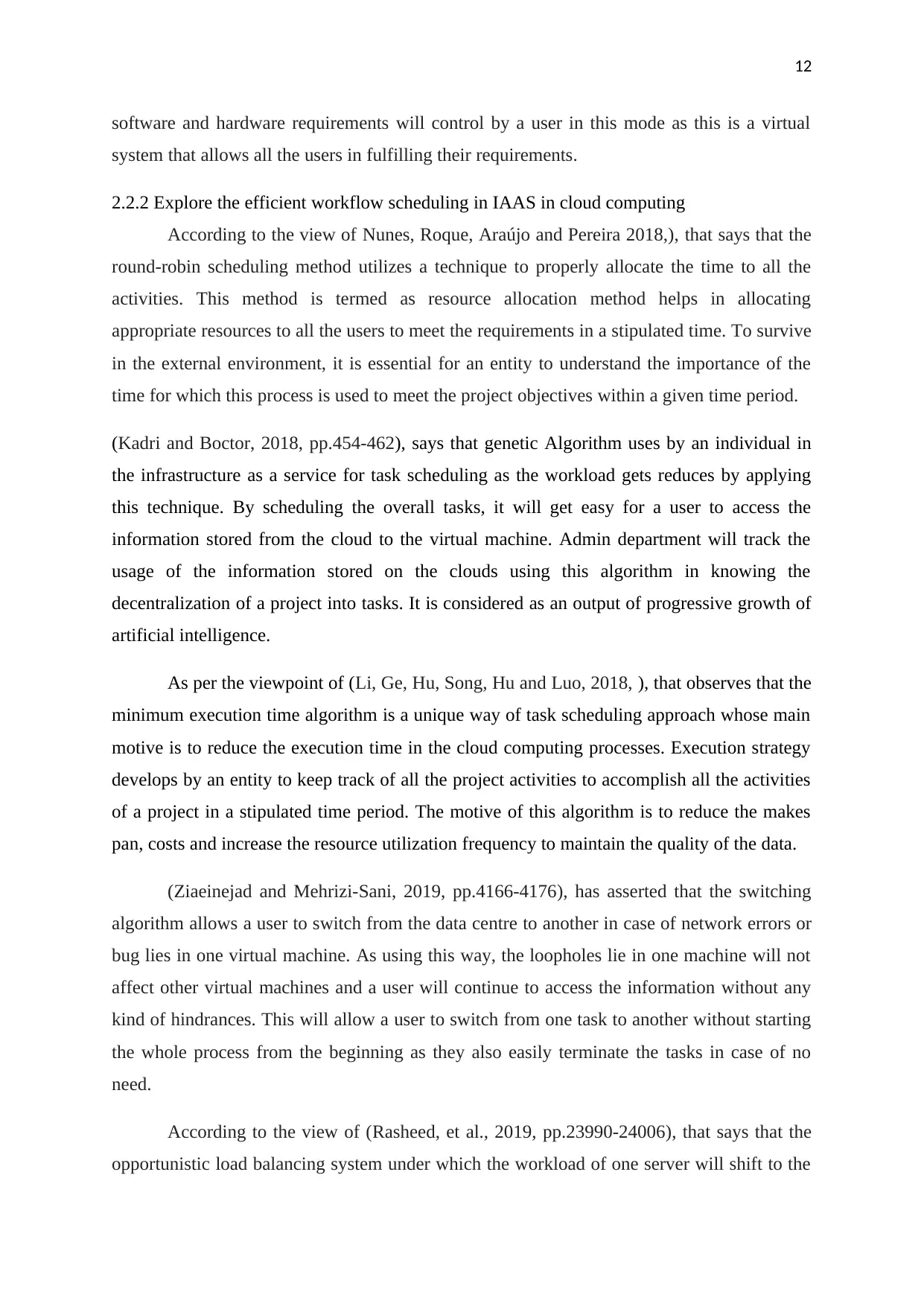
12
software and hardware requirements will control by a user in this mode as this is a virtual
system that allows all the users in fulfilling their requirements.
2.2.2 Explore the efficient workflow scheduling in IAAS in cloud computing
According to the view of Nunes, Roque, Araújo and Pereira 2018,), that says that the
round-robin scheduling method utilizes a technique to properly allocate the time to all the
activities. This method is termed as resource allocation method helps in allocating
appropriate resources to all the users to meet the requirements in a stipulated time. To survive
in the external environment, it is essential for an entity to understand the importance of the
time for which this process is used to meet the project objectives within a given time period.
(Kadri and Boctor, 2018, pp.454-462), says that genetic Algorithm uses by an individual in
the infrastructure as a service for task scheduling as the workload gets reduces by applying
this technique. By scheduling the overall tasks, it will get easy for a user to access the
information stored from the cloud to the virtual machine. Admin department will track the
usage of the information stored on the clouds using this algorithm in knowing the
decentralization of a project into tasks. It is considered as an output of progressive growth of
artificial intelligence.
As per the viewpoint of (Li, Ge, Hu, Song, Hu and Luo, 2018, ), that observes that the
minimum execution time algorithm is a unique way of task scheduling approach whose main
motive is to reduce the execution time in the cloud computing processes. Execution strategy
develops by an entity to keep track of all the project activities to accomplish all the activities
of a project in a stipulated time period. The motive of this algorithm is to reduce the makes
pan, costs and increase the resource utilization frequency to maintain the quality of the data.
(Ziaeinejad and Mehrizi-Sani, 2019, pp.4166-4176), has asserted that the switching
algorithm allows a user to switch from the data centre to another in case of network errors or
bug lies in one virtual machine. As using this way, the loopholes lie in one machine will not
affect other virtual machines and a user will continue to access the information without any
kind of hindrances. This will allow a user to switch from one task to another without starting
the whole process from the beginning as they also easily terminate the tasks in case of no
need.
According to the view of (Rasheed, et al., 2019, pp.23990-24006), that says that the
opportunistic load balancing system under which the workload of one server will shift to the
software and hardware requirements will control by a user in this mode as this is a virtual
system that allows all the users in fulfilling their requirements.
2.2.2 Explore the efficient workflow scheduling in IAAS in cloud computing
According to the view of Nunes, Roque, Araújo and Pereira 2018,), that says that the
round-robin scheduling method utilizes a technique to properly allocate the time to all the
activities. This method is termed as resource allocation method helps in allocating
appropriate resources to all the users to meet the requirements in a stipulated time. To survive
in the external environment, it is essential for an entity to understand the importance of the
time for which this process is used to meet the project objectives within a given time period.
(Kadri and Boctor, 2018, pp.454-462), says that genetic Algorithm uses by an individual in
the infrastructure as a service for task scheduling as the workload gets reduces by applying
this technique. By scheduling the overall tasks, it will get easy for a user to access the
information stored from the cloud to the virtual machine. Admin department will track the
usage of the information stored on the clouds using this algorithm in knowing the
decentralization of a project into tasks. It is considered as an output of progressive growth of
artificial intelligence.
As per the viewpoint of (Li, Ge, Hu, Song, Hu and Luo, 2018, ), that observes that the
minimum execution time algorithm is a unique way of task scheduling approach whose main
motive is to reduce the execution time in the cloud computing processes. Execution strategy
develops by an entity to keep track of all the project activities to accomplish all the activities
of a project in a stipulated time period. The motive of this algorithm is to reduce the makes
pan, costs and increase the resource utilization frequency to maintain the quality of the data.
(Ziaeinejad and Mehrizi-Sani, 2019, pp.4166-4176), has asserted that the switching
algorithm allows a user to switch from the data centre to another in case of network errors or
bug lies in one virtual machine. As using this way, the loopholes lie in one machine will not
affect other virtual machines and a user will continue to access the information without any
kind of hindrances. This will allow a user to switch from one task to another without starting
the whole process from the beginning as they also easily terminate the tasks in case of no
need.
According to the view of (Rasheed, et al., 2019, pp.23990-24006), that says that the
opportunistic load balancing system under which the workload of one server will shift to the
⊘ This is a preview!⊘
Do you want full access?
Subscribe today to unlock all pages.

Trusted by 1+ million students worldwide
1 out of 41
Related Documents
Your All-in-One AI-Powered Toolkit for Academic Success.
+13062052269
info@desklib.com
Available 24*7 on WhatsApp / Email
![[object Object]](/_next/static/media/star-bottom.7253800d.svg)
Unlock your academic potential
Copyright © 2020–2025 A2Z Services. All Rights Reserved. Developed and managed by ZUCOL.


